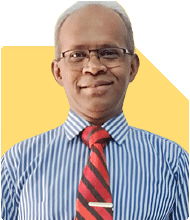Ramalingam Kalirajan |4149 Answers |Ask -Follow
Mutual Funds, Financial Planning Expert - Answered on Jun 30, 2024
He has an MBA in finance from the University of Madras and is a certified financial planner.
He is the director and chief financial planner at Holistic Investment, a Chennai-based firm that offers financial planning and wealth management advice.... more

Dear sir, I am 52 yrs old working in private organization . Due to work pressure and stress , I wish retire now. Having following saving/ investment. LIC - 25L, MF and equity- 20 lacs, real estate- 1 Cr. No EMI. Monthly expenses - 30K. Is it rt decision to retire now? Thank in advance...
Current Financial Overview
Your current assets include:
LIC Policies: Rs. 25 lakhs
Mutual Funds and Equity: Rs. 20 lakhs
Real Estate: Rs. 1 crore
You have no EMIs, and your monthly expenses are Rs. 30,000. This gives you a strong foundation, but there’s room for optimization.
Monthly Expenses and Future Projections
Your monthly expenses are Rs. 30,000, which amounts to Rs. 3.6 lakhs annually. Considering an average inflation rate of 6%, your expenses will increase over time. It’s important to plan for this gradual increase to ensure your savings last throughout your retirement.
Assessing Your Investments
LIC Policies
Surrendering LIC Policies
LIC policies provide security, but they may not offer the best returns compared to other investment options like mutual funds.
Consider surrendering your LIC policies and reinvesting the proceeds in mutual funds. This can provide better growth and more flexibility.
Mutual Funds and Equity
1. Benefits of Mutual Funds
Mutual funds offer diversification, professional management, and the potential for higher returns. Here’s why mutual funds can be a better option:
Diversification: Spread your investments across different sectors and companies, reducing risk.
Professional Management: Fund managers make informed decisions on where to invest your money.
Compounding: Over time, your investments can grow significantly due to the power of compounding.
2. Types of Mutual Funds to Consider
Invest in a mix of mutual funds to balance risk and returns:
Equity Mutual Funds: These invest in stocks and have the potential for high returns. Suitable for long-term growth.
Debt Mutual Funds: These invest in bonds and are less volatile. They provide stability and regular income.
Balanced or Hybrid Funds: These invest in both equities and debt, providing a balance between growth and stability.
3. Systematic Investment Plan (SIP)
A SIP allows you to invest a fixed amount regularly in mutual funds. This instills discipline and benefits from rupee cost averaging, reducing the impact of market volatility.
4. Systematic Withdrawal Plan (SWP)
An SWP provides regular income by withdrawing a fixed amount from your mutual fund investments. This can be a reliable source of income in retirement.
Implementing a Systematic Withdrawal Plan (SWP)
1. How SWP Works
In an SWP, you invest a lump sum in a mutual fund and withdraw a fixed amount periodically. This provides you with regular income while your remaining investment continues to grow.
2. Setting Up an SWP
Choose the Right Fund: Opt for a balanced or debt mutual fund to ensure stability.
Determine the Withdrawal Amount: Calculate your monthly expenses and set your withdrawal amount accordingly. Ensure it’s sustainable over the long term.
Monitor and Adjust: Regularly review your SWP to ensure it meets your income needs and adjust if necessary.
Managing Real Estate
1. Rental Income
If your real estate can generate rental income, this can be a steady source of funds. Ensure the rental income covers a substantial part of your monthly expenses.
2. Liquidity Considerations
Real estate is not very liquid. If you need cash quickly, selling property might take time. Hence, it’s crucial to have other liquid investments.
Healthcare and Insurance
1. Adequate Health Insurance
Ensure you have sufficient health insurance coverage. Medical emergencies can deplete your savings quickly. Consider enhancing your existing policy if necessary.
2. Emergency Fund
Maintain an emergency fund to cover unexpected expenses. This should be easily accessible and cover at least 6-12 months of living expenses.
Inflation Protection
1. Growth-Oriented Investments
Keep a portion of your portfolio in growth-oriented investments like equity mutual funds. This helps in beating inflation and maintaining your purchasing power.
2. Regular Review
Regularly review and adjust your investments to ensure they are aligned with your financial goals and inflation rate.
Retirement Withdrawal Strategy
1. 4% Rule
A commonly recommended strategy is the 4% rule. Withdraw 4% of your retirement portfolio annually, adjusted for inflation. This strategy helps balance income needs and preserve capital.
2. Diversify Withdrawals
Diversify your withdrawal sources. Combine income from SWPs, rental income, and other investments to ensure stability and sustainability.
Detailed Mutual Fund Strategy
1. Equity Mutual Funds
Invest in large-cap, mid-cap, and small-cap funds for growth. Large-cap funds offer stability, while mid-cap and small-cap funds provide higher growth potential.
2. Debt Mutual Funds
Invest in short-term and long-term debt funds for stability. These funds provide regular income with lower volatility.
3. Hybrid Funds
Hybrid funds, which invest in both equity and debt, offer a balanced approach. They provide growth and income stability.
Benefits of Regular Mutual Funds
1. Professional Management
Regular funds are managed by professionals. They make informed investment decisions, helping you achieve better returns.
2. Convenience
Investing through a Mutual Fund Distributor (MFD) with CFP credentials offers convenience. They handle paperwork and provide regular updates.
3. Diversification
Mutual funds offer diversification, spreading investments across different assets, reducing risk.
Avoiding Direct Funds
1. Lack of Guidance
Direct funds require you to choose and manage your investments. This can be challenging without proper knowledge and experience.
2. Time-Consuming
Managing direct funds requires regular monitoring and adjustments. This can be time-consuming and stressful.
Final Insights
Shiva, your decision to retire is significant, and with careful planning, it’s achievable. Here’s a summary to guide you:
Surrender LIC Policies: Reinvest the proceeds in mutual funds for better growth.
Diversify Mutual Fund Investments: Balance between equity, debt, and hybrid funds.
Set Up an SWP: Ensure a regular income stream while keeping your investments growing.
Generate Rental Income: If possible, use rental income to support your expenses.
Maintain Health Insurance and Emergency Fund: Ensure you are covered for unforeseen expenses.
Regular Review and Adjustments: Periodically review your investments and make necessary adjustments.
By following these steps, you can retire comfortably and confidently, knowing that your financial future is secure.
Best Regards,
K. Ramalingam, MBA, CFP,
Chief Financial Planner,
www.holisticinvestment.in
You may like to see similar questions and answers below
Ramalingam Kalirajan |4149 Answers |Ask -Follow
Mutual Funds, Financial Planning Expert - Answered on Jun 09, 2024
Nayagam P P |1132 Answers |Ask -Follow
Career Counsellor - Answered on Jul 02, 2024
Nayagam P P |1132 Answers |Ask -Follow
Career Counsellor - Answered on Jul 02, 2024
Nayagam P P |1132 Answers |Ask -Follow
Career Counsellor - Answered on Jul 02, 2024
Nayagam P P |1132 Answers |Ask -Follow
Career Counsellor - Answered on Jul 02, 2024
Nayagam P P |1132 Answers |Ask -Follow
Career Counsellor - Answered on Jul 02, 2024
Ramalingam Kalirajan |4149 Answers |Ask -Follow
Mutual Funds, Financial Planning Expert - Answered on Jul 02, 2024
Ramalingam Kalirajan |4149 Answers |Ask -Follow
Mutual Funds, Financial Planning Expert - Answered on Jul 02, 2024
Ramalingam Kalirajan |4149 Answers |Ask -Follow
Mutual Funds, Financial Planning Expert - Answered on Jul 02, 2024
Nayagam P P |1132 Answers |Ask -Follow
Career Counsellor - Answered on Jul 02, 2024
Ramalingam Kalirajan |4149 Answers |Ask -Follow
Mutual Funds, Financial Planning Expert - Answered on Jul 02, 2024

















